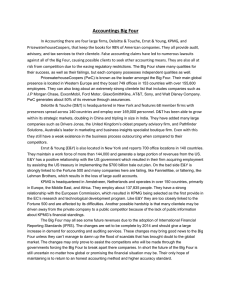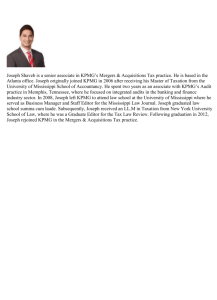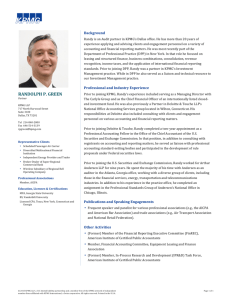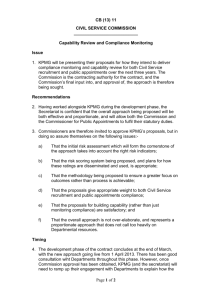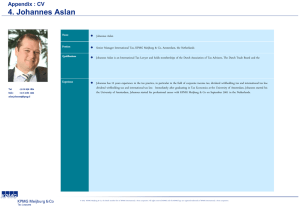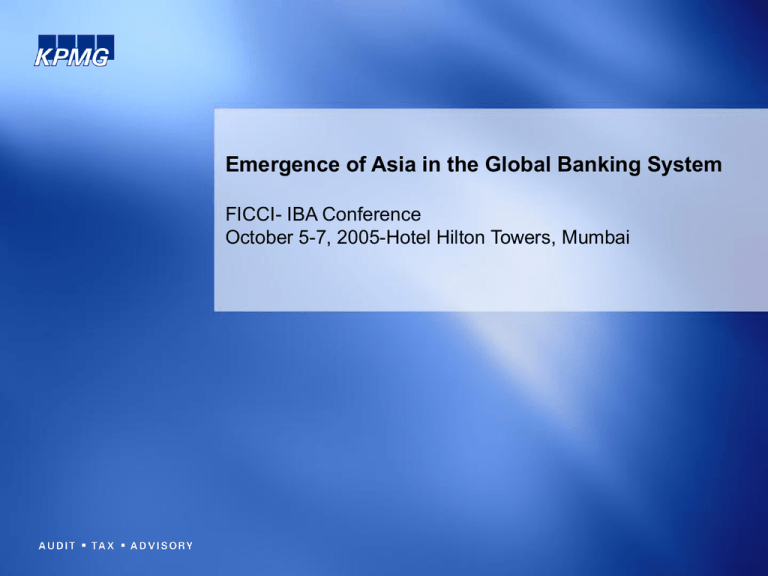
Emergence of Asia in the Global Banking System
FICCI- IBA Conference
October 5-7, 2005-Hotel Hilton Towers, Mumbai
Agenda
• Asia
• China and City Commercial banks
• Opportunities and Challenges
© 2005 KPMG India Private Limited, the sub-licensee of KPMG, the Indian member firm of KPMG International, a Swiss cooperative. All rights reserved.
2
Major Industry Events
Regulations
Repeal of Glass
Steagall Act
Hong Kong
Sovereignty to China
EURO Sarbanes Oxley
Spitzer & Banks
Corporate
Crises
Equitable Life
Crisis
EU Expansion to
25 nations
Spitzer & Insurance
WorldCom
Collapse of
Barings
Enron
Parmalat
Technology
Rapid uptake of telephone /
internet banking
Electronic trading
2000
1995
2005
2000
Products
Credit / Equity Derivatives
SocioEconomic
Far East
Crash
Rapid uptake in retail
hedge funds
9/11
Dotcom Boom
Global crash in equities
© 2005 KPMG India Private Limited, the sub-licensee of KPMG, the Indian member firm of KPMG International, a Swiss cooperative. All rights reserved.
3
Asia
Asia
Area: 30% of World’s
Population: 60% of World’s
Bangladesh
GDP: USD 56.3 bn
Area: 147,570 sq km
Population: 129,300,000
China
GDP: USD 1,681.3 bn
Area: 9,596,960 sq km
Population: 1,306,313,812
Japan
GDP: USD 4669.6 bn
Area: 377,899 sq km
Population: 127,600,000
South Korea
GDP: USD 680.7 bn
Area: 99,601 sq km
Population: 48,200,000
Hong Kong
GDP: USD 165.7 bn
Area: 1,098 sq km
Population: 6,803,100
India
GDP: USD 669.9 bn
Area: 3,287,590 sq km
Population: 1,080,264,388
Thailand
GDP: USD 163.5 bn
Area: 514,000 sq km
Population: 65,240,000
Singapore
GDP: USD 106.8 bn
Area: 682.3 sq km
Population: 3,500,000
Source: Economist Intelligence Unit
© 2005 KPMG India Private Limited, the sub-licensee of KPMG, the Indian member firm of KPMG International, a Swiss cooperative. All rights reserved.
4
Asia (contd.)
Asia’s demographic dividend - Dependency Rates*
80
75
• Working – age Asians driving
70
consumption patterns
Asia
North America
65
60
55
50
45
40
1990
1995
2000
2005
2010
2015
2020
2025
2030
2035
2040
2045
2050
Source: UN (* People aged under 15 and over 65 as % of people aged 15-65)
Growth Rate Per Capita GDP (% per year)
Gross Domestic Savings (% of GDP)
60
15
50
10
40
China
30
Hong Kong
South Korea
20
Malaysia
10
China
Hong Kong
5
South Korea
Malaysia
0
Singapore
-5
Thailand
Singapore
Thailand
0
1997
1998
1999
2000
2001
2002
2003
2004
India
-10
India
-15
1997
Source: Asian Development Outlook
1998
1999
2000
2001
2002
2003
2004
Source: Asian Development Outlook
© 2005 KPMG India Private Limited, the sub-licensee of KPMG, the Indian member firm of KPMG International, a Swiss cooperative. All rights reserved.
5
Asian Banking Industry – Present Status
Domestic Consolidation
Stages of
Consolidation
India
Taiwan
Attract Cross-border investments
Japan
Korea
China
Indonesia
Malaysia
Thailand
Regional/global expansion
Australia
New Zealand
Singapore
North America
Developed
European
Countries
Hong Kong
Market
Characteristics
• Fragmented
Domestic Market
• Large no. of small
and medium-sized
banks
• Improved bank structure
• Policies and guidelines to encourage
domestic consolidation
Government
Involvement
• Home market saturation
• Fewer but strong banks;
reduced risk for investors
• Schemes to restructure national and
state-owned banks
• Implementation of international banking standards,
e.g. Basel Accord, corporate governance, tax laws and
accountancy transparency
• Implement deregulation programs
• Develop capital markets, e.g. debt markets
• Changes to banking regulations to
reduce cross-holding
• Increase capital adequacy ratio
• Initiate deregulation initiatives
• Asia Financial Crisis
Drivers
• Bank Failures
• High domestic economic growth
• Economic growth requiring
• Increase shareholder value
additional capital from foreign
• Seeking growth opportunities
investors
• Competition
• Competition
Source: Deloitte – The Changing Landscape of Asian Banking
© 2005 KPMG India Private Limited, the sub-licensee of KPMG, the Indian member firm of KPMG International, a Swiss cooperative. All rights reserved.
7
Some key parameter trends in Asian banking
Loan Growth (percentage change YoY)
Volume
40.00%
30.00%
• Loan Growth
• Deposit Growth
• Loans to deposit ratio
20.00%
Hong Kong
10.00%
Singapore
Malaysia
0.00%
India
-10.00%
South Korea
-20.00%
-30.00%
1997
1998
1999
2000
2001
2002
2003
2004
2005
Loan-to-Deposits Ratio (percentage)
Deposit Growth (percentage change YoY)
40.0%
35.0%
30.0%
25.0%
20.0%
15.0%
Hong Kong
10.0%
Singapore
5.0%
Malaysia
0.0%
India
-5.0%
South Korea
-10.0%
1997 1998 1999 2000 2001 2002 2003 2004 2005
180.0%
160.0%
140.0%
120.0%
100.0%
80.0%
60.0%
40.0%
20.0%
0.0%
Hong Kong
Singapore
Malaysia
India
South Korea
1997 1998 1999 2000 2001 2002 2003 2004 2005
Source: Smith Barney, Citigroup
Result of intense competition and low credit demand, with different countries in different credit cycles
© 2005 KPMG India Private Limited, the sub-licensee of KPMG, the Indian member firm of KPMG International, a Swiss cooperative. All rights reserved.
8
Some key parameter trends in Asian banking
Bank Return on Assets (percentage)
2
1.5
India
1
Profitability
• Profitability in Asia’s biggest banks
smartly bounced back in 2004, as
compared to losses in 2003
• ROA and ROE have witnessed positive
uptrend
• Non-interest revenue is increasing
South Korea
0.5
Malaysia
0
Singapore
-0.5
Thailland
-1
2000
2001
2002
2003
2004
Source: IMF
Bank Return on Equity (percentage)
40
30
India
20
South Korea
10
Malaysia
0
Singapore
-10
Thailland
-20
2000
2001
2002
2003
2004
Information not available for Singapore and Indonesia in 2000
Source: IMF
© 2005 KPMG India Private Limited, the sub-licensee of KPMG, the Indian member firm of KPMG International, a Swiss cooperative. All rights reserved.
9
Some key parameter trends in Asian banking
Non-performing loans to total loans (percentage)
Asset quality
• Asset Quality continues to improve
• Banking reforms and restructuring
40
Hong Kong
30
India
20
South Korea
10
Malaysia
0
Singapore
2000
2001
2002
2003
2004
Thailland
China
schemes are having its effect
Source: IMF
Banking provisions to non-performing loans (percentage)
80
Indonesia
60
Malaysia
40
Philippines
20
Thailland
Japan
0
2000
2001
2002
2003
2004
Source: IMF
© 2005 KPMG India Private Limited, the sub-licensee of KPMG, the Indian member firm of KPMG International, a Swiss cooperative. All rights reserved.
10
Some global banks’ exposure to the region - HSBC
Assets
HSBC December
2004
USD bn
NPLs as % of total
loans
% total
Pre-tax Profit
USD bn
% total
Hong Kong
217
17.2%
1.0%
4,744
26.9%
Singapore
-
-
-
274
1.6%
Malaysia
-
-
-
216
1.2%
Thailand
-
-
-
59
0.3%
India
-
-
-
180
1.0%
Taiwan
-
-
-
108
0.6%
Total Asia-Pacific
(ex-HK)
121
9.5%
1.9%
1,805
10.3%
Europe
539
42.6%
2.2%
5,225
29.7%
Americas
388
30.7%
2.0%
5,834
33.1%
1.9%
17,608
Total
1,265
Source: Smith Barney, Citigroup
© 2005 KPMG India Private Limited, the sub-licensee of KPMG, the Indian member firm of KPMG International, a Swiss cooperative. All rights reserved.
11
Some global banks’ exposure to the region – Standard
Chartered
Assets
StanChart
December 2004
USD bn
NPLs as % of total
loans
% total
Pre-tax Profit
USD bn
% total
Hong Kong
48,459
27.2%
2.2%
629
29.1%
Singapore
20,419
11.5%
2.8%
254
11.8%
India
8,528
4.8%
2.4%
195
9.0%
Malaysia
7,130
4.0%
4.7%
124
5.7%
Other Asia-Pacific
21,424
12.0%
6.7%
267
12.4%
Total Asia-Pacific
(ex-HK)
57,501
32.3%
4.2%
840
38.9%
UAE & Other
MESA
12,864
7.2%
3.1%
378
17.5%
Africa, Americas,
UK & Group
59,228
33.3%
7.8%
311
14.4%
Total
178,052
4.1%
2,158
Source: Smith Barney, Citigroup
© 2005 KPMG India Private Limited, the sub-licensee of KPMG, the Indian member firm of KPMG International, a Swiss cooperative. All rights reserved.
12
Agenda
• Asia
• China and City Commercial banks
• Opportunities and Challenges
© 2005 KPMG India Private Limited, the sub-licensee of KPMG, the Indian member firm of KPMG International, a Swiss cooperative. All rights reserved.
13
1949 – 1978
Rmb11,725 bn
The Chinese economy has seen strong growth
Post 1978
WTO
The “Great
Leap
Forward”
1949 1952
1955
1958
1961
Cultural
Revolution
1964
1967
1970
1973
Economic reform
begins
1976
1979
1982
1985
1988
1991
China’s
GDP
1994
1997
2000
2003
Source: National Bureau of Statistics of China, China Statistical Yearbook
© 2005 KPMG India Private Limited, the sub-licensee of KPMG, the Indian member firm of KPMG International, a Swiss cooperative. All rights reserved.
14
Overview of the Chinese banking sector
China Banking
Sector
China Banking
Regulatory
Commission
State Policy
Banks (3)
State- owned
Commercial
Banks (4)
Total
assets:
Rmb 18.35
trillion
Notes:
Source:
Joint-stock
Commercial
Banks (12)
Total
assets:
Rmb 5.25
trillion
Commercial
Banks (~336)
City
Commercial
Banks (112)
Foreign Banks
(~200)
People’s Bank of
China
Credit
Cooperatives
(~30,000)
Rural
Commercial
Banks (8)
Urban Credit
Cooperatives
(~2,000)
Others(a)
Rural Credit
Cooperatives
(~28,000)
Total assets:
Rmb 1.80
trillion
Number of banks in brackets
Assets as at 30 June 2005 (a) Includes postal savings and other non-banking financial institutes
KPMG analysis of publicly available information
© 2005 KPMG India Private Limited, the sub-licensee of KPMG, the Indian member firm of KPMG International, a Swiss cooperative. All rights reserved.
15
City Commercial Banks
• Opportunities for foreign investors
- Relatively small investment
- Foreign investors can’t buy control
- City Commercial Banks are also looking
China banking industry share by assets 2004
Foreign Banks
2%
Others
7%
City Commercial
Banks
5%
Policy Banks
8%
for something
State-owned
Commercial Banks
54%
Cooperatives
9%
- Investing is a relatively easy – but
lengthy – process
Source: Asian Wall Street
Journal; China Banking
Regulatory Commission website
Joint-stock
Commercial Banks
15%
• Which banks are left?
China’s banking assets 2000-2004
• What issues have foreign investors
faced?
4
0.2
3.5
3
- Strategic alignment
- Local government control
- Key operating personnel
2.5
2
1.5
0.6
0.1
0.3
0.1
0.4
0.8
0.6
1.5
1.8
2
1.4
1.7
2000
2001
2002
2003
2004
0.1
0.2
0.7
1
0.9
City Commercial bank
Joint-stock banks
Others
1
0.5
0.2
0.5
0
© 2005 KPMG India Private Limited, the sub-licensee of KPMG, the Indian member firm of KPMG International, a Swiss cooperative. All rights reserved.
State-ow ned banks
Source: KPMG
Analysis, China’s city
commercial banks
16
Emerging Trends
• Improved oversight of the banking system
- Formation of Chinese Banking Regulatory Commission in early 2003
• Steps taken for asset disposal and recapitalisation
- USD 170 bn of NPLs transferred to ARCs by March 2004 and USD 60 bn worth of assets disposed off
• Reducing NPL Ratios
- NPL ratio of state-owned commercial bank was 16 percent in 2004 (Source: China Banking Regulatory Commission website
May 2005)
- Government has planned injection of capital
- NPL ratios have been decreasing, but are still some way off international levels
• Better Capital Adequacy
- Considerable progress made by Chinese banks in meeting Basel I Capital Adequacy of 8%
• Abundant growth in car and housing loan and bank - card business
© 2005 KPMG India Private Limited, the sub-licensee of KPMG, the Indian member firm of KPMG International, a Swiss cooperative. All rights reserved.
17
Emerging Trends contd.
Foreign strategic investors invited to take stakes in large banks
• August 2005
Goldman Sachs, American Express, Allianz took a combined stake of 10%
(worth USD 3 bn) in state-owned bank industrial and Commercial Bank of China
(ICBC)
• July 2005
Temasek invested USD 1 bn in China Construction Bank
• July 2005
Royal Bank of Scotland, Meryll Lynch and Li Ka-shing bought 10% of Bank of
China (BOC)
• June 2005
Bank of America invested USD 3.1 bn in China Construction Bank (CCB)
© 2005 KPMG India Private Limited, the sub-licensee of KPMG, the Indian member firm of KPMG International, a Swiss cooperative. All rights reserved.
18
Agenda
• Asia
• China and City Commercial banks
• Opportunities and Challenges
© 2005 KPMG India Private Limited, the sub-licensee of KPMG, the Indian member firm of KPMG International, a Swiss cooperative. All rights reserved.
19
Opportunities and Challenges
People management
Corporate
governance
Risk and
capital management
Efficiency and
cost management
Growth & Business
Development
© 2005 KPMG India Private Limited, the sub-licensee of KPMG, the Indian member firm of KPMG International, a Swiss cooperative. All rights reserved.
20
The information contained herein is of a general nature and is not intended to address the circumstances of any particular individual or entity. Although we endeavor to
provide accurate and timely information, there can be no guarantee that such information is accurate as of the date it is received or that it will continue to be accurate
in the future. No one should act on such information without appropriate professional advice after a thorough examination of the particular situation.
Presenter’s contact details
Russell Parera,
National Industry Director, Financial Services
KPMG
India
+91 (22) 2491 3030
rparera@kpmg.com
www.in.kpmg.com
© 2005 KPMG India Private Limited, the sub-licensee of KPMG, the Indian member firm of KPMG International, a Swiss cooperative. All rights reserved.
21

